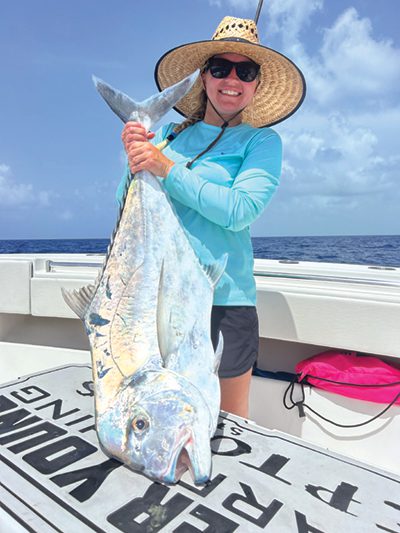
During the winter months in the Florida Keys, we hear a lot about wahoo, sailfish, and other mackerel species that travel through with the cooler water temperatures. However, one fish that is very special and often forgotten about is african pompano “AP”. Landing an AP on hook and line, or spear, is a huge accomplishment and usually underappreciated. Don’t get me wrong, catching a sailfish or shooting a wahoo is a thrill of a lifetime, but having an african pompano hit the deck is a moment that does not come along very often! Let’s dive in and break down some tactics that will help you make the most of your offshore trips this coming winter.
It is not a secret that AP’s like hanging around wrecks or deep structure, but homing in on the conditions that they favor will take some time. These fish are generally in pairs or small schools, swimming tight circles around the structure they are on. We often see african pompano on the reef as well, however here they are traveling and usually do not stay in one place for very long. 
You probably won’t hear many divers say this, but I truly believe that shooting an african pompano is far more difficult that any wahoo or grouper. For instance, the last wahoo I shot was in 14’ of water and my last AP was shot in over 80’ of water. Landing a large AP on a single breath is a huge undertaking and great accomplishment. These fish are always deeper, they are hard to approach, the shot needs to be perfect, and like all other jacks they dive straight down when hit. I only run slip tips with a float line for this reason, when targeting AP’s. You need to place the shot near the pectoral fin, which will catch good bone and hold well as you fight the fish. They will try to swim down to the structure they are on, and all this commotion will attract the predators. Goliath groupers love to bust in and break up the party, they will try to eat your fighting fish until you get them far enough off the bottom. I believe it is important to fight the fish immediately and if you have three divers in the water, have one of them dive down and assist by pulling on your float line. If your shot is placed right, it will hold and your tension from pulling will help turn their head up, this will make it easier to surface your fish. Shooting AP’s near the tail will almost always lead to a tear out or a predator eating them. Because these fish swim down when shot, it is important to keep your line clear from your body as you bring them in. Enjoy every second and know that landing an african pompano is one of the most difficult fish to shoot in the Florida Keys.
The winter months are here and it’s our opportunity to catch our favorite cooler water pelagic fish! Pay attention to the conditions you have success with and never miss an opportunity to get out on the water. Be courteous of other divers and anglers, know that everyone has the right to be out diving and fishing. No boat, fishing or diving, has the right over another boat.
Dive Safe!
